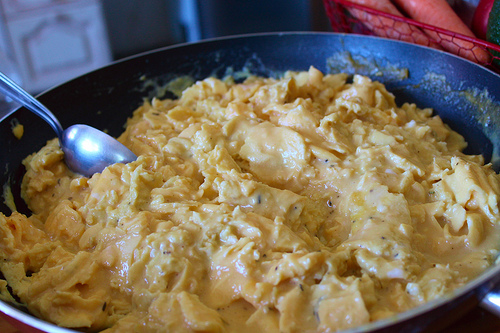When I was growing up, I wasn’t allowed to watch television.
Well, I suppose that’s not entirely true. I was allowed to watch two shows: Mr. Rogers and Sesame Street, both of which were featured on public television. As a result, nearly twenty years later (… excuse me… writing that nearly killed me), I can still recite the voice-over credits thanking the Helena Rubenstein Foundation “and viewers like you” by heart. I also know how crayons are made.
Part of Mr. Rogers’ schtick, aside from the whole world of Make-Believe, was the fact that he had a painting hung in his living room that allowed the viewer to journey to cool places–mostly factories. My absolute favorite was an inside look at how crayons were made: the wax was colored and poured into molds, and my five-year-old eyes were astounded to see hundreds of thousands of orange crayons in a line, wrapped in paper and stuck into a box alongside all the other colors I knew from similar boxes of crayons I had at home. It was life-changing.
So imagine how much stranger it was to see something much more important to me than crayons made from start to finish; in the life of a writer, I can think of nothing more essential than that which makes our trade possible (although the irony of writing this on a blog does not escape me): paper.
That’s right: one of those new excursions I mentioned yesterday was to the Moulin à Papier de Brousses, an artisanal paper mill in a small town about an hour’s drive from where we live in Paziols.
We were lucky to be able to spend a full day at the mill: we started with a tour that reminded me of the crayon video, a tour that led us, not only through the production cycle, but through the history of paper, from the very first papyrus all the way up to modern mechanics and machinery. We learned about the history of the paper mill in Brousses, how the grandson of one of the original millers decided to reopen the mill after it had been closed as a tourist attraction and artisanal mill, where all the paper would be made by hand. Some was sold in the small shop, and we browsed for a few minutes as we awaited our next activity: paper-making.
I watched (and snapped pictures) as the girls launched themselves into the task, first painting hand-made paper with dye to create personalized sheets, and then experimenting with making two of their own sheets of paper by hand.
It’s nothing like the carbon copies we buy in reams for our printers: these sheets have faults and tears, like people. Seeing each individual sheet come off the mold made me think of how many sheets of paper I waste every day on to-do lists and half-finished recipes copied quickly off the internet for use in the kitchen.
So what does all of this have to do with scrambled eggs? Maybe not much… but like the good food blogger I am, I’m still going to try. The eggs, you see, are like the crayons and the paper: something simple and ubiquitous, at first glance… perhaps the simplest of egg preparations. It’s hard to completely ruin scrambled eggs (as long as you don’t overcook them), and unlike an omelette or a fried egg, there is little technique involved aside from stirring.
But like this paper, when done properly, scrambled eggs can become so much more than scrambled eggs. Eggs, cream, butter, salt parsley… everything comes together, and suddenly, I’m reminded of when Julie Powell compared her first egg to cheese sauce. It’s not a mere egg: it’s creamy and decadent, and even if you leave out the cream and replace it with milk for an everyday breakfast, it feels completely decadent.
I, of course, left in the cream: I’m growing ever famous here in Paziols for my heavy hand with all things butter and crème fraîche, but I haven’t heard any complaints yet. The day I served these eggs, though, I didn’t hear much of anything… I was too busy hovering over the stove, making pancakes, muffins, eggs benedict and mimosas for thirty. Why?
…
Why not?
Slow-Cooked Scrambled Eggs
1 Tbsp. butter
20 eggs
2 tsp. salt
25 cl. crème fraiche
1 handful fresh flat-leaf parsley, chopped
Melt the butter over low heat in a skillet. Whisk the eggs together loosely with a fork, then pour into the pan.
Allow the eggs to sit for 1-2 minutes before beginning to stir. Add the salt, then, with a wooden spoon, stir frequently (nearly constantly), until the eggs form curds, about 5-10 minutes depending on your stovetop. Add the crème fraîche and parsley, and stir until the eggs are just solid. Remove from the heat and pour into a warmed bowl for serving. The eggs will continue to cook slightly after being removed from the heat, so bear this in mind when deciding to remove them.








What a charming outing this is! And creme fraiche in eggs? So decadent. Could I get away with this outside of France??? My daughters and I luv your blog – we included you on a list of blogs we recently discovered and want to recommend! Thanx for a great blog!